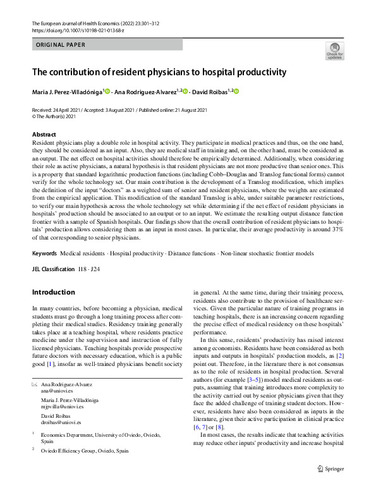The contribution of resident physicians to hospital productivity
Autor(es) y otros:
Fecha de publicación:
Versión del editor:
Citación:
Descripción física:
Resumen:
Resident physicians play a double role in hospital activity. They participate in medical practices and thus, on the one hand, they should be considered as an input. Also, they are medical staff in training and, on the other hand, must be considered as an output. The net effect on hospital activities should therefore be empirically determined. Additionally, when considering their role as active physicians, a natural hypothesis is that resident physicians are not more productive than senior ones. This is a property that standard logarithmic production functions (including Cobb–Douglas and Translog functional forms) cannot verify for the whole technology set. Our main contribution is the development of a Translog modification, which implies the definition of the input “doctors” as a weighted sum of senior and resident physicians, where the weights are estimated from the empirical application. This modification of the standard Translog is able, under suitable parameter restrictions, to verify our main hypothesis across the whole technology set while determining if the net effect of resident physicians in hospitals’ production should be associated to an output or to an input. We estimate the resulting output distance function frontier with a sample of Spanish hospitals. Our findings show that the overall contribution of resident physicians to hospi- tals’ production allows considering them as an input in most cases. In particular, their average productivity is around 37% of that corresponding to senior physicians.
Resident physicians play a double role in hospital activity. They participate in medical practices and thus, on the one hand, they should be considered as an input. Also, they are medical staff in training and, on the other hand, must be considered as an output. The net effect on hospital activities should therefore be empirically determined. Additionally, when considering their role as active physicians, a natural hypothesis is that resident physicians are not more productive than senior ones. This is a property that standard logarithmic production functions (including Cobb–Douglas and Translog functional forms) cannot verify for the whole technology set. Our main contribution is the development of a Translog modification, which implies the definition of the input “doctors” as a weighted sum of senior and resident physicians, where the weights are estimated from the empirical application. This modification of the standard Translog is able, under suitable parameter restrictions, to verify our main hypothesis across the whole technology set while determining if the net effect of resident physicians in hospitals’ production should be associated to an output or to an input. We estimate the resulting output distance function frontier with a sample of Spanish hospitals. Our findings show that the overall contribution of resident physicians to hospi- tals’ production allows considering them as an input in most cases. In particular, their average productivity is around 37% of that corresponding to senior physicians.
ISSN:
Notas Locales:
OA ATUO21
Ficheros en el ítem





